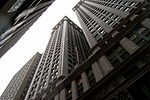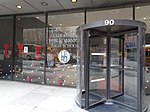Trinity and United States Realty Buildings
Broadway (Manhattan)Francis H. Kimball buildingsGothic Revival architecture in New York CityHistoric district contributing properties in ManhattanNew York City Designated Landmarks in Manhattan

The Trinity Building, designed by Francis H. Kimball and built in 1905, with an addition of 1907,: 1 and Kimball's United States Realty Building of 1907,: 1 located respectively at 111 and 115 Broadway in Manhattan's Financial District, are among the first Gothic-inspired skyscrapers in New York, and both are New York City designated landmarks. The Trinity Building, adjacent to the churchyard of Richard Upjohn's neo-Gothic Trinity Church, replaced an 1853 Upjohn structure of the same name.: 3 Earlier, the Van Cortlandt sugar house stood on the west end of the plot – a notorious British prison where American soldiers were held during the Revolutionary War.
Excerpt from the Wikipedia article Trinity and United States Realty Buildings (License: CC BY-SA 3.0, Authors, Images).Trinity and United States Realty Buildings
Thames Street, New York Manhattan
Geographical coordinates (GPS) Address Nearby Places Show on map
Geographical coordinates (GPS)
| Latitude | Longitude |
|---|---|
| N 40.7088 ° | E -74.0115 ° |
Address
Big Al's Chicago Style Pizza
Thames Street 9
10006 New York, Manhattan
New York, United States
Open on Google Maps








